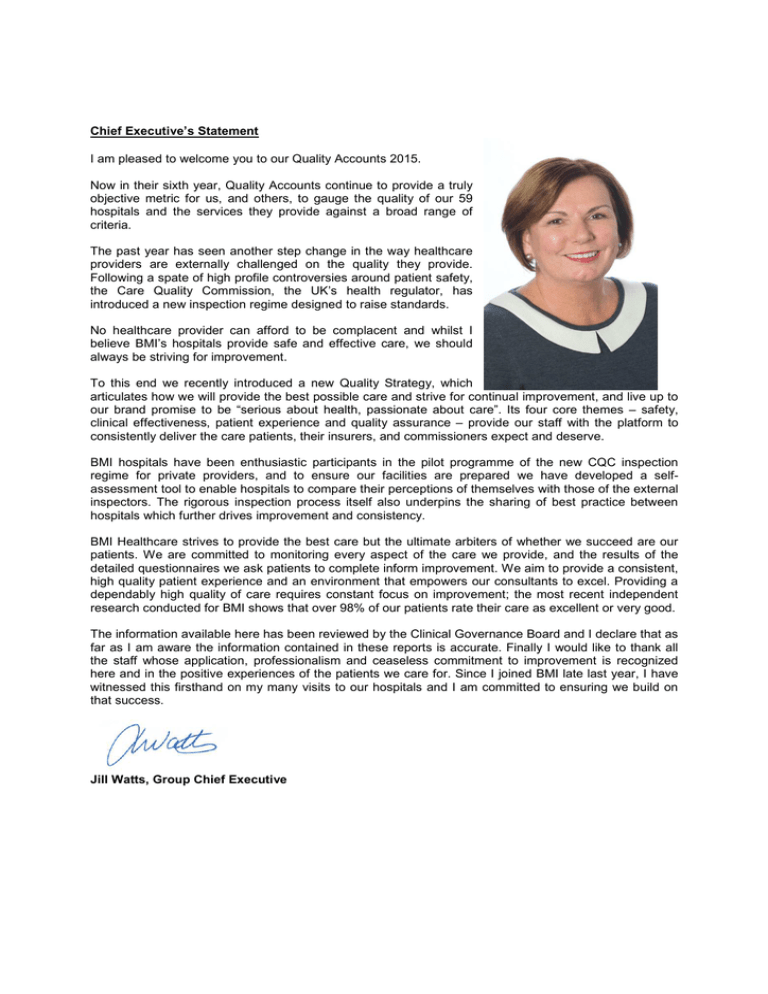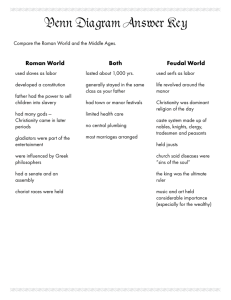
Chief Executive’s Statement
I am pleased to welcome you to our Quality Accounts 2015.
Now in their sixth year, Quality Accounts continue to provide a truly
objective metric for us, and others, to gauge the quality of our 59
hospitals and the services they provide against a broad range of
criteria.
The past year has seen another step change in the way healthcare
providers are externally challenged on the quality they provide.
Following a spate of high profile controversies around patient safety,
the Care Quality Commission, the UK’s health regulator, has
introduced a new inspection regime designed to raise standards.
No healthcare provider can afford to be complacent and whilst I
believe BMI’s hospitals provide safe and effective care, we should
always be striving for improvement.
To this end we recently introduced a new Quality Strategy, which
articulates how we will provide the best possible care and strive for continual improvement, and live up to
our brand promise to be “serious about health, passionate about care”. Its four core themes – safety,
clinical effectiveness, patient experience and quality assurance – provide our staff with the platform to
consistently deliver the care patients, their insurers, and commissioners expect and deserve.
BMI hospitals have been enthusiastic participants in the pilot programme of the new CQC inspection
regime for private providers, and to ensure our facilities are prepared we have developed a selfassessment tool to enable hospitals to compare their perceptions of themselves with those of the external
inspectors. The rigorous inspection process itself also underpins the sharing of best practice between
hospitals which further drives improvement and consistency.
BMI Healthcare strives to provide the best care but the ultimate arbiters of whether we succeed are our
patients. We are committed to monitoring every aspect of the care we provide, and the results of the
detailed questionnaires we ask patients to complete inform improvement. We aim to provide a consistent,
high quality patient experience and an environment that empowers our consultants to excel. Providing a
dependably high quality of care requires constant focus on improvement; the most recent independent
research conducted for BMI shows that over 98% of our patients rate their care as excellent or very good.
The information available here has been reviewed by the Clinical Governance Board and I declare that as
far as I am aware the information contained in these reports is accurate. Finally I would like to thank all
the staff whose application, professionalism and ceaseless commitment to improvement is recognized
here and in the positive experiences of the patients we care for. Since I joined BMI late last year, I have
witnessed this firsthand on my many visits to our hospitals and I am committed to ensuring we build on
that success.
Jill Watts, Group Chief Executive
Hospital Information
BMI The Manor Hospital has 21 beds with all rooms
offering the privacy and comfort of en-suite facilities, free
view TV, Wi-Fi and telephone. The hospital has one
theatre, endoscopy department / minor procedure room
and another minor operation room within the Out Patients
department.
These facilities combined with the on-site support services
including Imaging / Ultrasound, Physiotherapy and Health
Screening; enable our consultants to undertake a wide
range of procedures from routine investigations to complex
surgery. The specialist expertise is supported by caring
and professional medical staff, with dedicated nursing
teams and a Resident Medical Officer on duty 24 hours a
day, providing care within a friendly and comfortable
environment.
We also run the Choose and Book programme this
includes services such as General Surgery, Gynecology,
Urology and Gastroenterology. The NHS Orthopedics
service is from Circle contract. 22% of all our overall
referrals are NHS patients.
BMI Healthcare is registered as a provider with the Care Quality Commission (CQC) under the
Health & Social Care Act 2008. BMI The manor Hospital is registered as a location for the
following regulated services:•
•
•
Treatment of disease, disorder and injury
Surgical procedures
Diagnostic and screening
The CQC carried out an unannounced inspection on 10th October 2013 and found that people
who use the service were provided with suitable and sufficient information including
preadmission and discharge packs. People told us the information was very useful. They said
they'd received good explanations about their care and treatment and felt fully informed. They
told us they felt well looked after throughout the course of their care and treatment and this had
included undergoing an assessment process before and on arrival at the service. Our review of
their care files confirmed this. We saw that the explanations provided to people including the
risks and benefits involved in any procedures were well documented. People had received a
review of their medical histories and allergies in all the cases we looked at and were having
specific risk factors reviewed and updated regularly. The people we spoke with said they found
staff to be friendly and competent. The staff we spoke with said they were completing a program
of training relevant to their roles and received appraisals of their competencies and
development. The documentation we looked at confirmed this. We saw that the service
appeared clean during our inspection. However, we found that some infection control processes
and practices were lacking. People told us they had no complaints about the service. We saw
the service had a complaints process in place and people's complaints were responded to
appropriately.
Standards of treating people with respect and involving them in their care
Met this standard
Standards of providing care, treatment & support which meets people's needs
Met this standard
Standards of caring for people safely & protecting them from harm
X
Action needed
Standards of staffing
Met this standard
Standards of management
Met this standard
For the above non-compliance, replacements of Gradus impervious floor covering with hard
flooring- risk assessment have now been completed. A robust action plan was put in place.
New replacement flooring in all patient rooms now replaces the carpets. Training was provided
to all staff with further audits and action plans locally completed.
The Manor Hospital has a local framework through which clinical effectiveness, clinical incidents
and clinical quality is monitored and analysed. Where appropriate, action is taken to
continuously improve the quality of care. This is through the work of a multidisciplinary group
and the Medical Advisory Committee.
Regional Clinical Quality Assurance Groups monitor and analyse trends and ensure that the
quality improvements are operationalised. At corporate level the Clinical Governance Board has
an overview and provides the strategic leadership for corporate learning and quality
improvement.
There has been ongoing focus on robust reporting of all incidents, near misses and outcomes.
Data quality has been improved by ongoing training and database improvements. New reporting
modules have increased the speed at which reports are available and the range of fields for
analysis. This ensures the availability of information for effective clinical governance with
implementation of appropriate actions to prevent recurrences in order to improve quality and
safety for patients, visitors and staff.
At present we provide full, standardised information to the NHS, including coding of procedures,
diagnoses and co-morbidities and PROMs for NHS patients. There are additional external
reporting requirements for CQC, Public Health England (Previously HPA) CCGs and Insurers
BMI is a founding member of the Private Healthcare Information Network (PHIN) UK – where
we produce a data set of all patient episodes approaching HES-equivalency and submit this to
PHIN for publication. The data is made available to common standards for inclusion in
comparative metrics, and is published on the PHIN website http://www.phin.org.uk. This website
gives patients information to help them choose or find out more about an independent hospital
including the ability to search by location and procedure.
1. Safety
1.1 Infection prevention and control
The focus on infection prevention and control continues under
the leadership of the Group Head of Infection Prevention and
Control, in liaison with the link nurse in The Manor Hospital
The focus on infection prevention and control continues under
the leadership of the Group Director of Infection Prevention and
Control and Group Head of Infection Prevention and Control, in
liaison with the Infection Prevention and Control Lead The
Manor Hospital.
We have had: • Zero cases MRSA bacteraemia cases/100,000 bed days
• Zero cases MSSA bacteraemia cases /100,000 bed
days
• Zero Cases E.coli bacteraemia cases/ 100,000 bed days
• Zero cases of hospital apportioned Clostridium difficile in the last 12 months.
• SSI data is also collected and submitted to Public Health England for Orthopaedic
surgical procedures. Our rates of infection are;
o Hips zero
o Knees zero
BMI The Manor Hospital under took the annual infection control audit. Action plans were written
and actioned by all departments from several areas of the audit. No specific trends were noted.
Seven Care Bundles were audited during this period and include Pre-operative, Intra-operative,
Post-Operative, urinal catheterisation, Urinary Catheter on-going care, Peripheral Cannula
insertion and Peripheral Cannula on going care.
10 separate observations were made of nurses and doctors in each area with the hospital.
Training focused on hand hygiene, aseptic non touch technique and other infection prevention
activities were also carried out with a compliance of 81%.
Environmental cleanliness is also an important factor in infection prevention and our patients
rate the cleanliness of our facilities highly.
Graph below shows hospital room and bathroom cleanliness scores (% of excellent and very
good)
Environmental cleanliness is also an important factor in infection prevention and our patients
rate the cleanliness of our facilities highly.
1.2 Patient Led Assessment of the Care Environment (PLACE)
We believe a patient should be cared for with compassion and dignity in a clean, safe environment.
Where standards fall short, they should be able to draw it to the attention of managers and hold the
service to account. PLACE assessments will provide motivation for improvement by providing a clear
message, directly from patients, about how the environment or services might be enhanced.
In 2013 we introduced PLACE, which is the new system for assessing the quality of the patient
environment, replacing the old Patient Environment Action Team (PEAT) inspections.
The assessments involve patients and staff who assess the hospital and how the environment
supports patient’s privacy and dignity, food, cleanliness and general building maintenance. It focuses
entirely on the care environment and does not cover clinical care provision or how well staff are
doing their job.
The results will show how hospitals are performing nationally and locally.
1.3 Venous Thrombo-embolism (VTE)
BMI Healthcare, holds VTE Exemplar Centre status by the Department of Health across its
whole network of hospitals including, The Manor Hospital. BMI Healthcare was awarded the
Best VTE Education Initiative Award category by Lifeblood in February 2013 and were the
Runners up in the Best VTE Patient Information category.
We see this as an important initiative to further assure patient safety and care. We audit our
compliance with our requirement to VTE risk assessment every patient who is admitted to our
facility and the results of our audit on this has shown 100% compliance.
The Manor Hospital reports the incidence of Venous Thromboembolism (VTE) through the
corporate clinical incident system. It is acknowledged that the challenge is receiving information
for patients who may return to their GPs or other hospitals for diagnosis and/or treatment of VTE
post discharge from the Hospital. As such we may not be made aware of them. We continue to
work with our Consultants and referrers in order to ensure that we have as much data as
possible. .
BMI The Manor Hospital have had no incidents concerning VTE within this period.
2. Effectiveness
2.1 Patient reported Outcomes (PROMS)
Patient Reported Outcome Measures (PROMs) are a means of collecting information on the
effectiveness of care delivered to NHS patients as perceived by the patients themselves.
PROMs are a Department of Health led programme.
Latest results can be found by going on the online SOLAR system provided to you by Quality
Health
For the current reporting period, the tables below demonstrate that the health gain between
Questionnaire 1 (pre-operative) and Questionnaire 2 (post–operative) for patients undergoing
hip replacement and knee replacement at The Manor Hospital.
April 14 – September 14
The Manor Hospital
England
Oxford Hip Score average
Health gain between reporting
Q1
Q2
periods
0
0
Less than 30 responses therefore no
data
18.16
40.081
21.922
Copyright © 2013, The Health and Social Care Information Centre. All Rights Reserved.
April 14 – September 14
The Manor Hospital
England
Oxford Knee Score average
Health gain between reporting
Q1
Q2
periods
0
0
Less than 30 responses therefore no
data
19.401
36.103
16.702
Copyright © 2013, The Health and Social Care Information Centre. All Rights Reserved.
2.2 Enhanced Recovery Programme (ERP)
The ERP is about improving patient outcomes and speeding up a patient’s recovery after
surgery. ERP focuses on making sure patients are active participants in their own recovery and
always receive evidence based care at the right time. It is often referred to as rapid recovery, is
a new, evidence-based model of care that creates fitter patients who recover faster from major
surgery. It is the modern way for treating patients where day surgery is not appropriate.
ERP is based on the following principles:1. All Patients are on a pathway of care
a. Following best practice models of evidenced based care
b. Reduced length of stay
2. Patient Preparation
a. Pre Admission assessment undertaken
b. Group Education sessions
c. Optimizing the patient prior to admission – i.e. HB optimisation, control comorbidities, medication assessment – stopping medication plan.
d. Commencement of discharge planning
3. Proactive patient management
a. Maintaining good pre-operative hydration
b. Minimising the risk of post-operative nausea and vomiting
c. Maintaining normothermia pre and post operatively
d. Early mobilisation
4. Encouraging patients have an active role in their recovery
a. Participate in the decision making process prior to surgery
b. Education of patient and family
c. Setting own goals daily
d. Participate in their discharge planning
The Manor Hospital has good results with ERP targets ensuring patients are discharged within 3
day post joint replacement surgery. Introduction of Carbo-loading has improved patient recovery
and average length of stay. An active ERP group within the hospital led this initiative forward
including consultant support.
2.3 Unplanned Readmissions within 31 days and unplanned returns to theatre.
Unplanned readmissions and unplanned returns to theatre are normally due to a clinical
complication related to the original surgery.
Unplanned Readmission within 31
days (rate per 100 discharges)
0.35
0.3
0.25
0.2
0.15
0.1
0.05
0
2010
2011
2012
2013
2014
Unplanned readmissions and transfers out, all appropriately dealt with and no trends identified.
Continue to monitor. Increase from last year would be in line with the increase of NHS work
particularly with the Circle contract.
3. Patient experience
3.1 Patient satisfaction
BMI Healthcare is committed to providing the highest levels of quality of care to all of our
patients. We continually monitor how we are performing by asking patients to complete a patient
satisfaction questionnaire. Patient satisfaction surveys are administered by an independent third
party.
.
3.2 Complaints
In addition to providing all patients with an opportunity to complete a satisfaction survey BMI
The Manor Hospital actively encourages feedback both informally and formally. Patients are
supported through a robust complaints procedure, operated over three stages:
Stage 1: Hospital resolution
Stage 2: Corporate resolution
Stage 3: Patients can refer their complaint to independent adjudication if they are not satisfied
with the outcome at the other 2 stages.
All complaints are dealt with promptly and closed appropriately, No themes are recognised.
4. CQUINS
5. 1 (local) FFT STAFF
Description
of Indicator
Performance
The indicator will be a composite of feedback
via BMI staff to support service improvement
The quarterly feedback forms will provide
feedback on the same two questions as set out
in the guidance with the opportunity to provide
a free-text comment after each question.
Action plans will be developed based on
responses received and progress reported
through quarterly reports to commissioners
Q4
FFT - implementing staff survey across all
areas for each quarter (BMI say Q4)
Yes
1.1 FFT early implementation in outpatients and day cases
Description
of Indicator
Early Implementation of FFT - show
implementation by October 2014 to day case
and outpatients.
Performance
FFT - achieving early implementation / phased
expansion in line with national milestones (Y/N)
Target
Yes
1.2 FFT increase response rate for inpatients
Description
of Indicator
Increased or maintained response rate Q4
30%
Performance
Increased response rate 30% by Q4
Target
30%
Q4
36.18%
1.3 FFT stretch target inpatients
Description
of Indicator
Increased or maintained response rate
40%
Performance
Increased response rate 40% by Q4
Q4
Target
40%
36.18%
2 (local) Outpatient letter audit
Description
of Indicator
Investigative CQUIN to audit delays in
dispatching outpatient letters following
attendance within 5 working days
Performance
Quarter 1: Baseline audit identifying
themes and trends.
Quarter 2: Development and
Implementation of action plans
Quarter 3: Re-audit to identify
improvement
Quarter 4: Evidence of findings and
actions
Q4
Target
97.6%
5. National Clinical Audits
BMI The Manor Hospital was only eligible to participate in National Joint Registry audit and all
joint replacements are submitted to this.
2014/15
Fiscal
Quarter
Fiscal
Month
No. of
Ops
No. in
edit
No. of
Knees
No. of
Hips
No. of
Ankles
No. of
Elbow s
No.of
Consent Consent
Shoulders
Yes
No
Consent
Don't
Know
NHS
NHS
Consent Num ber Num ber
Rate
Supplied Traced
NHS
Num ber
Tracing
Rate
No. w ith Validation
Validate Override
Override
Rate
Q1
April
14
7
7
0
0
0
14
0
0
100%
10
14
100%
0
0%
Q1
May
15
7
7
0
0
1
15
0
0
100%
7
15
100%
0
0%
Q1
June
17
6
11
0
0
0
17
0
0
100%
5
17
100%
0
0%
Q2
July
10
4
5
0
0
1
9
1
0
90%
5
8
80%
0
0%
Q2
August
13
8
4
0
0
1
13
0
0
100%
6
12
92%
0
0%
Q2
September
18
10
8
0
0
0
18
0
0
100%
9
18
100%
0
0%
Q2
October
17
5
10
0
0
2
17
0
0
100%
8
16
94%
0
0%
Q3
November
12
4
8
0
0
0
12
0
0
100%
5
12
100%
0
0%
Totals:
116
51
60
0
0
5
115
1
0
99%
55
112
97%
0
0%
Key to consent:
Red if lower than 80%
0
Amber if equal to or greater than 80% and lower than 95%
Green if 95% or more
6. Research
No NHS patients were recruited to take part in research.
7. Priorities for service development and improvement
Continued work planned on development of staff to ensure a high level of clinical expertise and
be the local employer of choice within the independent sector.
Upgrade of our Out Patients department to enhance our quality services and environment.
To complete external decoration to provide a good first impression and appeasing appearance
of the facility
Regular review of quality questionnaires received from patients and utilizes feedback
constructively to improve services provided.
8. Mandatory Quality Indicators
8.1 The value of the summary hospital-level mortality indicator (SHMI) for The Manor Hospital
for the reporting period.
Unit
0
Reporting Periods
(at least last two
reporting periods)
Oct 2012 – Jun 2014
National
Average
Highest National
Score
Lowest National
Score
0.9987
1.1849
0.58345
The BMI Manor Hospital has reported no deaths for the current year.
8.2 The patient reported outcome measures scores for
(i) Groin hernia surgery
Unit
0.832
Reporting Periods
(at least last two
reporting periods)
Apr 14 – Sept 14
National
Average
Highest National
Score
Lowest National
Score
0.0786
0.278
-0.112
The BMI Manor Hospital considers that this data is as described.
The BMI Manor Hospital will continue to review the average length of stay and pain
management options to improve this number, and so the quality of its services, following best
practice guidelines and improved outcomes for the patient.
(ii) Varicose vein surgery
Unit
N/A
Reporting Periods
(at least last two
reporting periods)
Apr 14 – Sept 14
National
Average
Highest National
Score
Lowest National
Score
-7.395
-1.957
-12.571
The BMI Manor Hospital does not undertake Varicose Vein surgery via NHS route.
(iii) Hip replacement surgery
Unit
No score
Reporting Periods
(at least last two
reporting periods)
Apr 14 – Sept 14
National
Average
Highest National
Score
Lowest National
Score
21.542
28.6
9.714
The BMI Manor Hospital considers that this data is as described because there were less than
30 patients going through this process in the year covered in the report.
(iv) Knee replacement surgery during the reporting period.
Unit
No score
Reporting Periods
(at least last two
reporting periods)
Apr 14 – Sept 14
National
Average
Highest National
Score
Lowest National
Score
16.641
24.429
5.833
The BMI Manor Hospital considers that this data is as described because there were less than
30 patients going through this process in the year covered in the report.
8.3 (i) The BMI Manor Hospital does not see or treat patients under age of 16 years old.
Unit
N/A
Reporting Periods
(at least last two
reporting periods)
Apr 11 - Mar 12
National
Average
Highest National
Score
Lowest National
Score
11.45
14.35
7.96
8.3. (ii)The percentage of patients aged 15 or over readmitted to a hospital which forms part of
the BMI Manor Hospital within 28 days of being discharged from a hospital which forms part of
the hospital during the reporting period.
Unit
0.3275
Reporting Periods
(at least last two
reporting periods)
Apr 11 – Mar 12
National
Average
Highest National
Score
Lowest National
Score
10.01
14.51
5.54
The BMI Manor Hospital considers that this data is as described for the following reasons good
assessment and planned care throughout episode of treatment leading to good outcome.
The BMI Manor Hospital intends to review these incidents and monitor any trends to improve
this score.
8.4 The BMI Manor Hospital responsiveness to the personal needs of its patients during the
reporting period.
Unit
98.25
Reporting Periods
(at least last two
reporting periods)
2013-2014
National
Average
Highest National
Score
Lowest National
Score
68.7
85
54.4
The BMI Manor Hospital considers that this data is as described for the following reasons
quality planned nursing care throughout episode of treatment, leading to a good outcome.
The BMI Manor Hospital will continue to monitor this and review any trends that arise to keep
the good score.
8.5 The percentage of patients who were admitted to BMI Manor Hospital and who were risk
assessed for venous thromboembolism during the reporting period.
Unit
100%
Reporting Periods
(at least last two
reporting periods)
Apr 14 – Jan 15
National
Average
Highest National
Score
Lowest National
Score
95
100
87
The BMI Manor Hospital considers that this data is as described for the following reasons good
monitoring by clinical staff.
The BMI Manor Hospital will continue to monitor and audit to keep this percentage and prevent
potential complications. Audits will be discussed by clinical team.
8.6 The rate per 100,000 bed days of cases of C difficile infection reported within the BMI Manor
Hospital amongst patients aged 2 or over during the reporting period.
Unit
NIL
Reporting Periods
(at least last two
reporting periods)
Apr 13 – Mar 14
National
Average
Highest National
Score
Lowest National
Score
14.7
37.1
0
The BMI Manor Hospital considers that this data is as described for the following reasons the
excellent infection prevention and control measures in place to prevent, and raised awareness
amongst staff.
The BMI Manor Hospital prides itself in this score and will continue to monitor procedures and
provide training for clinical staff to prevent any occurrences.
8.7 The number and, where available, rate of patient safety incidents reported within the BMI
The Manor Hospital during the reporting period, and the number and percentage of such patient
safety incidents that resulted in severe harm or death.
Number of patient safety incidents reported
Unit
NIL
Reporting Periods
(at least last two
reporting periods)
Oct 13 – Sep 14
National
Average
Highest National
Score
Lowest National
Score
20
139
0
Rate of patient safety incidents reported (Incidents per 100 Bed Days)
Unit
NIL
Reporting Periods
(at least last two
reporting periods)
Oct 13 – Sep 14
National
Average
Highest National
Score
Lowest National
Score
3.589
7.496
0.0245
Number of patient safety incidents that resulted in severe harm or death
Unit
NIL
Reporting Periods
(at least last two
reporting periods)
Oct 13 – Sept 14
National
Average
Highest National
Score
Lowest National
Score
40.2
97
0
Percentage of patient safety incidents that resulted in severe harm or death (Incidents per 100
Admissions)
Unit
NIL
Reporting Periods
(at least last two
reporting periods)
Oct 13 – Sept 14
National
Average
Highest National
Score
Lowest National
Score
0.3
2.4
0.0
The BMI Manor Hospital considers that this data is as described for the following reasons good
staff education and risk assessment completion on all patients with measures put in place to
ensure patients are as safe as possible during their stay.
The BMI Manor Hospital reviews all incidents and action plan put in place when necessary to
ensure a quality service is provided at all times.
8.8 The percentage of staff employed by the (name of hospital) during the reporting period, who
would recommend the BMI The Manor Hospital as a provider of care to their family or friends.
Unit
71%
Reporting Periods
(at least last two
reporting periods)
2014
National
Average
Highest National
Score
Lowest National
Score
64.58
96.43
33.73
The BMI Manor Hospital considers that this data is as described for the following reasons the
scores are based on extremely likely and moderately likely response however all staff would
recommend if you take into account the likely score.
9. Non-Mandatory Quality Indicators
9.1 The percentage of patients who received care as inpatients or discharged from A &E during
the reporting period, who would recommend the BMI Manor Hospital as a provider of care to
their family or friends.
Unit
85.67%
Reporting Periods
(at least last two
reporting periods)
Jun 13 – Jan 14
National
Average
Highest National
Score
Lowest National
Score
66.23
94.38
35.63
The BMI Manor Hospital considers that this data is as described and continues to monitor all
patients’ response through patient questionnaires given on discharge.







